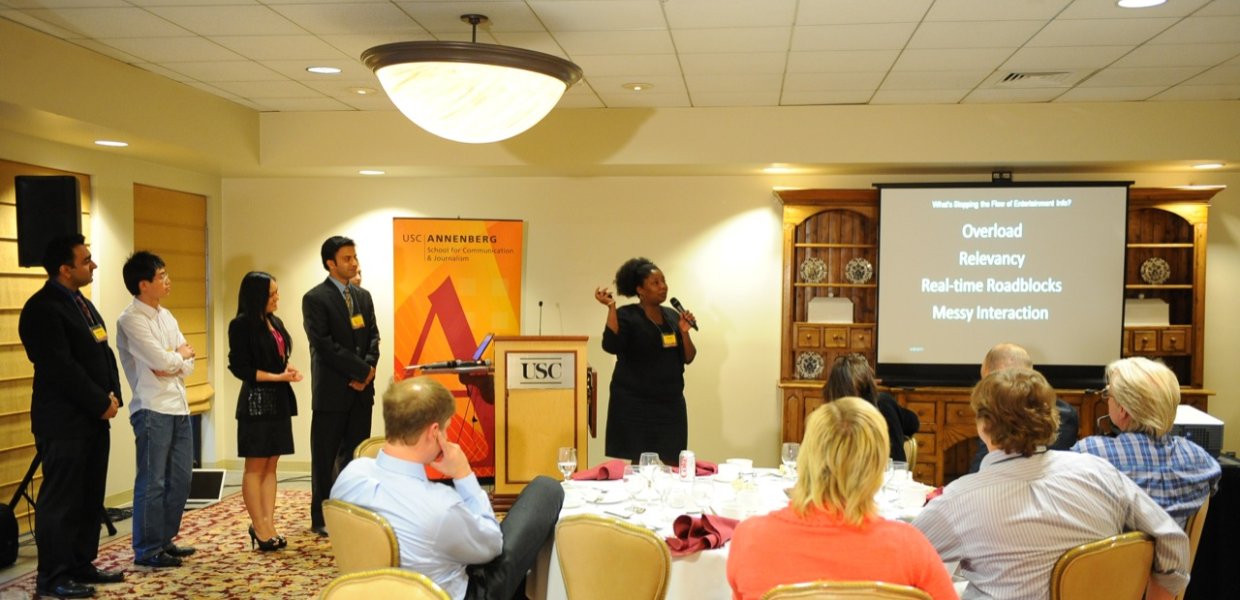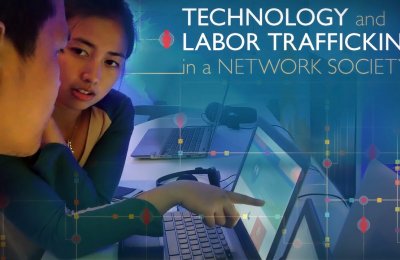Seventeen journalism, communication, engineering and business students from USC gathered Thursday night and presented to four news organizations new concepts, backed by research, for mobile news applications tailored for each of their operations.
The news agencies – The Associated Press, Variety, KCRW FM and La Opinión – had opened their doors to fellows of the program called the 2011 News Idea Incubator: Mobile News Solutions, a nine-day fellowship sponsored by a USC Annenberg family. Students split into groups and spent a full day at each news organization, exploring its business model, day-to-day operations and progress on the mobile apps currently in use.
It’s the collaboration among USC Annenberg, the Marshall School of Business and Viterbi School of Engineering that makes the fellowship unique, said School of Journalism director Geneva Overholser, who came up with the idea for the project and has been a champion of it. Once the students are joined together as teammates, she says, the chemistry works.
“Why not bring together a bunch of talented, hungry students from each of these schools and just really say, ‘Go to it!’ and pair them with news organizations that have certain needs,” Overholser told the audience, which included investors. “These are people from very different disciplines, each with an important stake in the future of journalism – how to use digital tools, how to support economically what we invent, and of course how do we keep an eye on the public interest.”
Maria Nikias (B.A. Broadcast Journalism ’11) said working with Viterbi students gave her practical insight that will shape how she thinks about the news business in her work life.
“It was really valuable, because as journalists we come up with ideas, but we don’t know how it would be feasible in the actual interface," Nikias said. "They taught us about things like text mining and ways to make the application seem more realistic and ways to really put it into practice.”
The fellowship, now in its second year, is unique not only because of the interdisciplinary collaboration but also because it offers students a behind-the-scenes look at news operations from the business side. Leaders of the organizations shared strategic information, some of it confidential, with students as they developed their app proposals.
“We liked having people with a very diverse set of expertise all coming together and collaborating and looking at what we do from an outsider’s view,” said Erin Madigan White, AP’s manager of product and customer coordination. She works as the agency’s liaison between the newsroom and its mobile product team. “A lot of times you’re in the zone, and it’s nice to have a refreshing view of your organization and to look at things through a new lens.”
For AP, students designed “AP Fizz” to overcome the problem of the “fire hose” of information that comes across the entertainment wire. Users would check the boxes of celebrities, artists and movies they’re interested in, and the app would sort and compile news relevant to those interests. The app also emphasized the branding of AP reporters, capitalizing on their role as a trusted source of information. Users would follow individual reporters and deepen their connection with them, building loyalty to AP.
For La Opinión, “Piensa Digital, Hazlo Movil” (Think digital, make it mobile) would focus first on flip-phones, targeting readership that doesn’t use smart phones. Users would send in texts to subscribe and would receive news alerts on health, employment, education, shopping, sports, etc., that would connect them more closely to the news organization and give them ways to phone in tips, questions and even news feeds. “Having a voice” is a theme the app emphasizes.
For Variety, “V-Time” would capitalize on the paper’s deep archives to give users access to a unique resource. Celebrity and industry leaders’ bio pages would be hyperlinked to real-time news and archived news stories. The targeted audience would be users looking to make industry deals, students said. “The goal is to help people conduct business. To help them push the deal through,” said team leader Josh Podell, who just received an MBA from Marshall.
For KCRW FM, “KCRW Connect” would create a way for users to clip snippets of audio in real time for sharing on social networks, as a way to connect KCRW listeners and strengthen their bond with the station. Listeners would be able to see who’s attending KCRW events, with attendees from Facebook highlighted in a graphic image. The idea, students said, is to foster a KCRW community.
“It was right on point. Nice job,” Michael Dutton, AP’s global director of entertainment and lifestyles product development, said of his group’s presentation.
“I love the notion of presenting the news in a tag cloud,” he said, referring to one aspect of the proposal, which uses photos of different sizes to visually represent the user’s highest-priority news topics. “I liked seeing some dedicated thinking on that because it speaks to how you can ultimately dedicate resources toward your newsgathering. You can see what’s working and what’s not, and you can chase down a story and do follow-ups depending on information you get from end users.”
The idea of mining Variety’s archives and using them in connection with breaking news is one the paper may be interested in pursuing, said film editor Josh Dickey. “They latched onto a great idea – that Variety archives are a valuable resource and finding ways to leverage them. Hyperlinking key words off a breaking news story into something deeper in the archives is a smart idea. I’d like to see us do that in the future, not only with our mobile app but will all of our online applications.
“This was a great example of how a new perspective can help you.”
Nonny de la Peña , a co-leader of the fellowship along with Erin Reilly of the Annenberg Innovation Lab, said news organization leaders already were talking with students about how to continue their conversations and share more ideas.
“The students have shown remarkable energy and resourcefulness in trying to design solutions for a news industry that is in chaos. The students turned this moment of crisis into an opportunity for change.”
What do you think? Join the conversation on our Facebook page .









